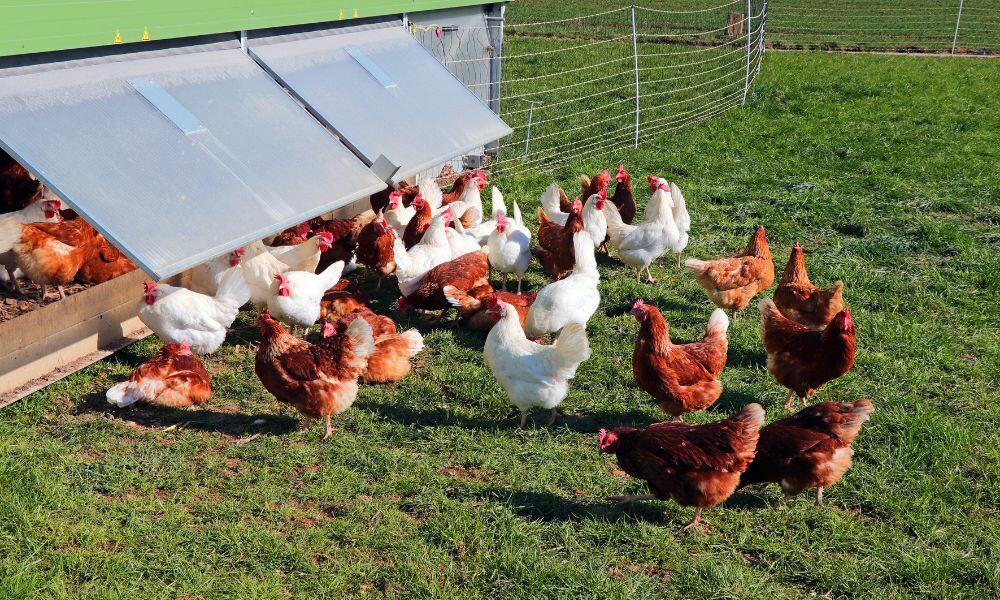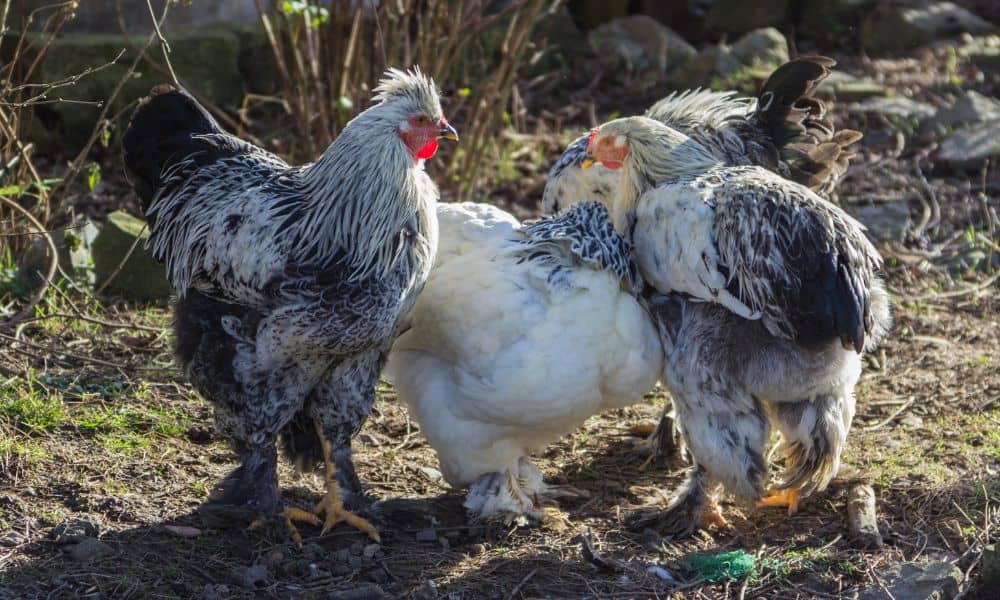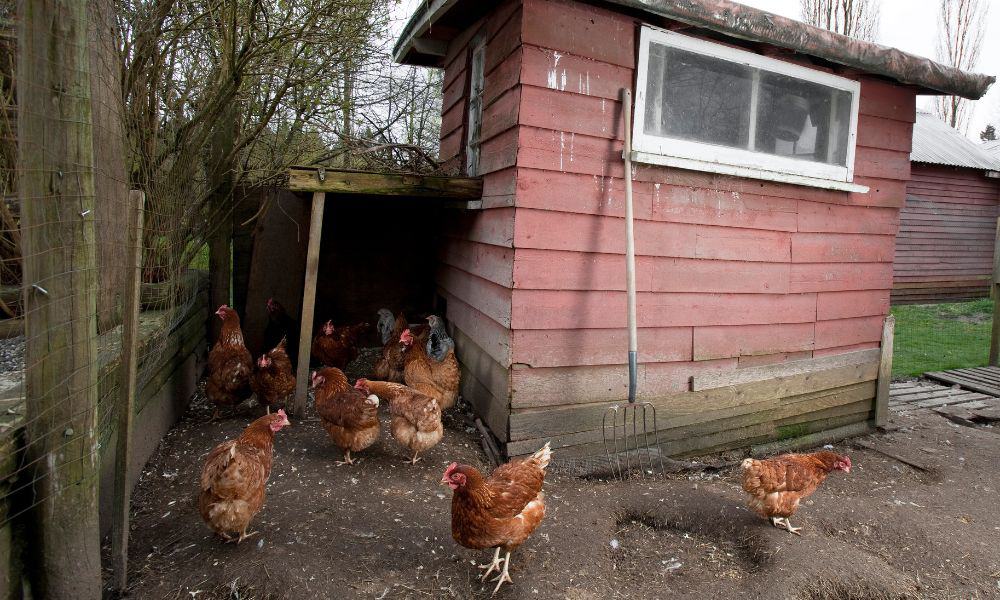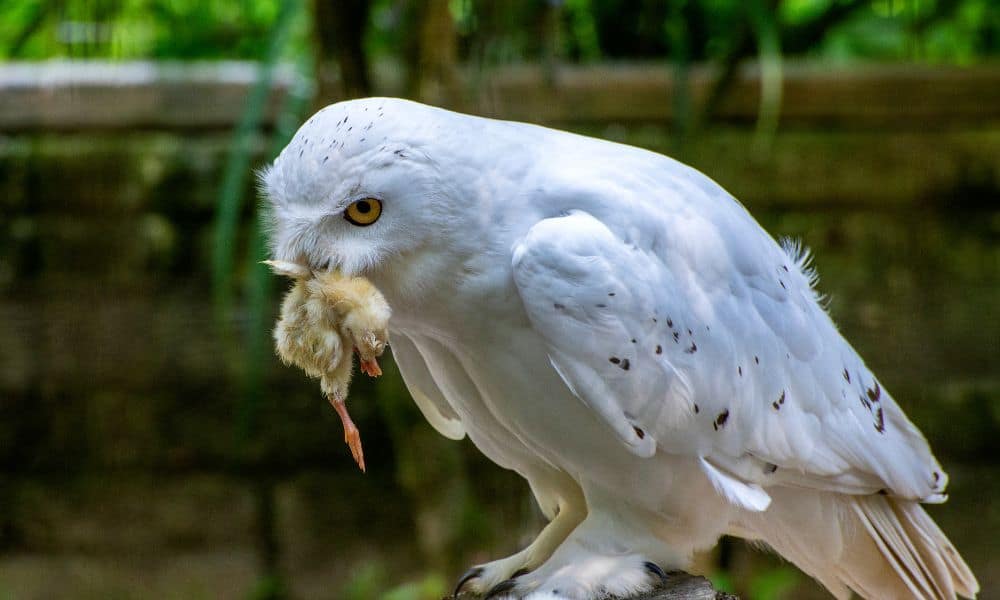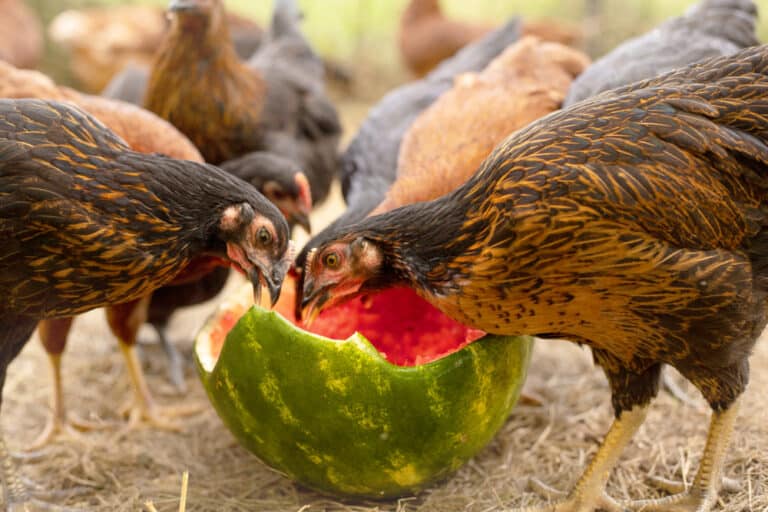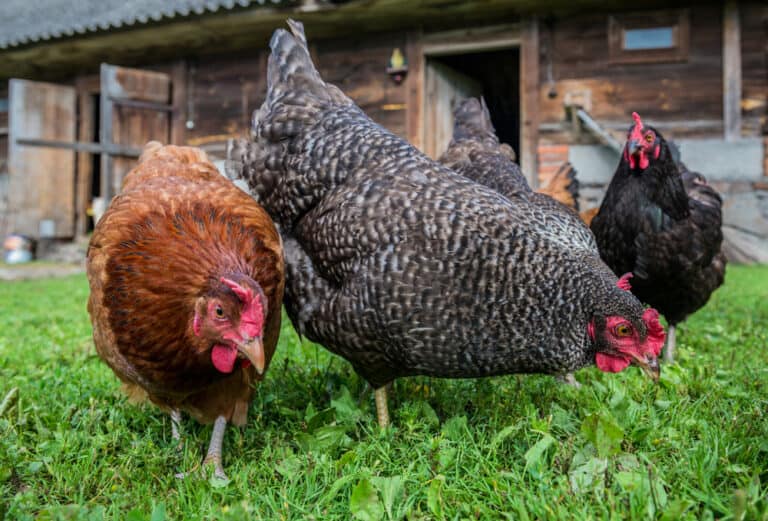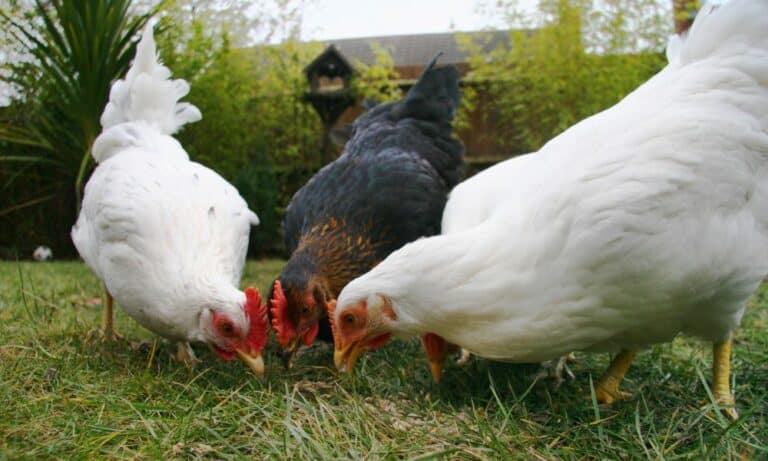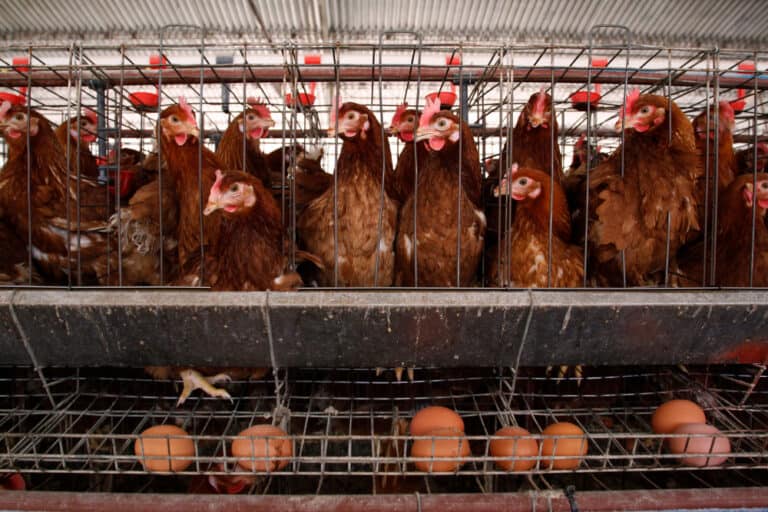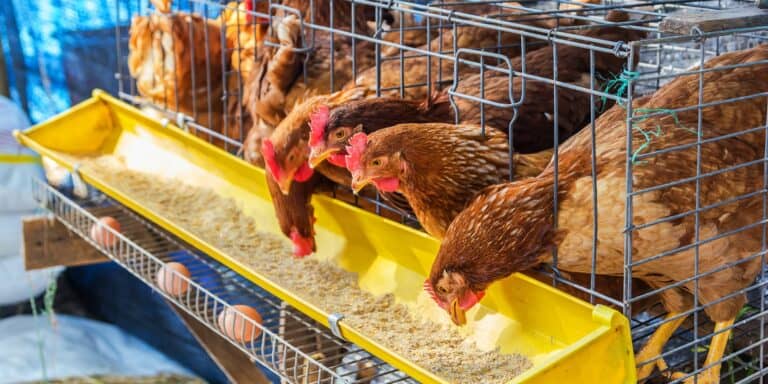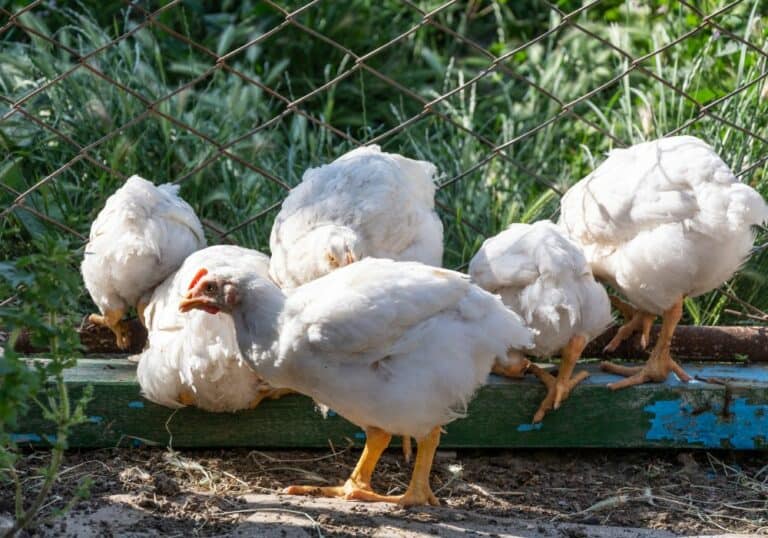Nowadays, most poultry lives only during their production period and go to slaughter afterward. Therefore, you may wonder how long do chickens live without human interference. It usually depends on the breed, environment, and medical care.
For instance, heritage breeds almost always live longer than hybrids. Those living freely in the wild can reach old age unless becoming prey. On the other hand, the lifespan of chickens living in captivity typically depends on humans. Let’s take a look.
Chicken breeds lifespan |
|
| Breed | Expected lifespan |
| Green Junglefowl | 12 to 14 years |
| Bantam breeds | 10+ years |
| Sri Lankan Junglefowl | 10 years |
| Grey Junglefowl | 10 years |
| Cochin | 8 to 10 years |
| Easter Egger | 8 to 10 years |
| Orpington | 8 to 10 years |
| Silkie 7-9 Years | 7 to 9 years |
| Wyandotte | 6 to 12 years |
| Australorp | 6 to 10 years |
| Plymouth Rock | 6 to 10 years |
| Rhode Island Red | 5 to 10 |
| Jersey Giants | 5 to 6 years |
| Leghorn | 4 to 6 years |
| Golden Comet (hybrid) | 4 to 5 ears |
| Red Junglefowl | 3 to 11+ years |
| ISA Brown | 2 to 3 years |
| Cornish Cross (hybrid) | Approximately 12 months |
How Long Do Chickens Live?
Most domesticated chickens live approximately 7 to 10 years, but some wild species can reach a lifespan of 14+ years. On the other hand, most poultry used in the industry never stays alive after the production period ends.
When excluding premature slaughter, you can determine chickens’ average lifespan based on breed. For instance, Finnish Landrace is among the longest-living chickens. These birds have passed long natural selection in specific environmental conditions and live over a decade on average.
On the other hand, several chicken breeds are on the brink of extinction. For instance, the traditional Japanese breed Ongadori with an unbelievably long tail is critically endangered, with a population of only 250 to 1,000 birds.
Another endangered breed is Burmese because only a few breeders are interested in their preservation. They are native to Myanmar but were considered to be extinct after WWI. Luckily, enthusiasts discovered a few surviving individuals in the 1970s and recreated this lovely breed with unusually long leg feathers.
Modern long- and short-living breeds
Unfortunately, breeds bred for high production rarely live over three years. Chickens with the shortest lifespan are ISA Brown, Cornish Rock, Cornish Cross hybrid, and White Broilers.
You can sometimes help your chickens live longer by providing a good coop, feeding them adequate food, and taking them to the vet when needed. If you are looking for long-lived chicken breeds, the best options are:
Plymouth Rock – It is a long-living hybrid breed with excellent genetics, making it resistant to various diseases. These chickens can survive 10 to 12 years.
Wyandottes – These heirloom chickens have an astonishing genetic profile and can effortlessly reach 6 to 12 years in an adequate environment.
Orpingtons – Fluffy heritage Orpingtons are an excellent option for your backyard. They have an average lifespan of 8 to 10 years in ideal living conditions.
Rhode Island Reds – These hardy, self-sufficient heritage chickens are unbelievably productive in laying eggs. When kept outdoors, they can live over eight years.
Easter Eggers – These cross-breed (hybrid) chickens produce attractive colorful eggs, making them favorable poultry living on small farms. Since they are never meant for high egg production, you can expect your hens to live over eight years.
Bantam breeds – Many people keep the heritage and hybrid Bantam breeds as pets, so most reach old age. Their average lifespan is over a decade when living freely.
Cochins – Fluffy Cochins are a long-living breed that can reach 8 to 10 years under adequate circumstances. Unfortunately, they are prone to obesity, reducing their maximum lifespan.
Factors Affecting Chicken Life Expectancy
Chickens’ life expectancy depends on various factors, primarily the breed, age, and provided living conditions. While genetics play a crucial role in poultry health, proper diet, and safe surroundings can significantly affect their longevity.
1. Breed
There is a sizable difference between heirloom and hybrid chickens’ lifespans. Besides, domesticated birds bred for food always end their lives as soon as they become unprofitable.
Wild chickens
Most chicken breeds living in the wild can reach three to seven years. However, they can live longer in a safe environment without predators endangering their lives. You can recognize four existing Junglefowl species, including:
- Green Junglefowl has a maximum estimated lifespan of 12 to 14 years
- Red jungle fowl native in southeast Asia has a lifespan of 3 to 11+ years
- Sri Lankan Junglefowl and Grey Junglefowl live for about a decade
Chickens living in captivity
Domesticated chickens can live up to 10 years with adequate diet and care, but most never reach their maximum lifespan. Birds kept for egg or meat production finish their purpose within a year or two and go to slaughter.
Chickens living as pets
People sometimes keep beautiful, typically small chicken breeds as pets, particularly when having children. However, they can do it when living where keeping chickens is legalized and have a backyard convenient for this purpose.
Well-fed chickens protected from predators have a long lifespan and can reach 10 to 15 years with proper vet care. Muffy, that died after a 22-year-long life in Maryland, the US, was probably the oldest officially recorded chicken worldwide.
Chickens used in the food industry
The food industry keeps chickens for two purposes. Hens for egg-laying live for 18 to 24 months before getting slaughtered when their production decreases.
On the other hand, broiler chickens for meat production live only 47 days. It can sometimes happen that fast-growing breeds have only 35-day-long life and get slaughtered after reaching a profitable weight of 4.85 pounds (2.2 kg).
These birds never reach their living potential, and their lifespan is always abnormally shortened. In fact, they never reach maturity, which is naturally 16 to 24 weeks.
2. Gender
Both broiler chick genders used for meat production live the same until getting slaughtered. The situation is entirely different in the egg industry. Since males are useless for laying eggs, they finish their lives when they are only several hours old.
Unlike over 6 billion newborn male chicks killed that way, hens typically live a year or two while their ability to lay eggs is at its peak. Only those living on small farms or as pets reach older ages.
3. Diet
In the past, chickens ate whatever they could find or grabbed leftovers farmers toss to their way. Nowadays, their diet is well-balanced and precisely manufactured for every life stage.
Unfortunately, farm chickens are often overweight because of widely available treats and reduced walking. Therefore, they are prone to numerous health issues.
For instance, those living in industrial complexes often suffer from heart and respiratory problems, while their backs and legs are typically deformed. Finally, hens that eat too many proteins because of higher egg production and have low water intake suffer from kidney issues.
Remember that calcium is necessary for laying hens. Low intake always ends up with eggs having too thin and fragile shells. On the other hand, calcium levels over 4% typically lead to leg abnormalities.
4. Housing (living conditions)
Modern purpose-built coops are designed to keep the space air-ventilated and the temperature and humidity at the required levels. That way, chickens get enough warmth in the winter and are cooled in summer, increasing their lifespan.
Such living conditions also protect poultry from predators and provide shelter whenever needed.
Unfortunately, factory farms provide miserable conditions, and chickens often live in overcrowded cages without the possibility to walk or spread their wings. Lack of mental stimulation causes mutual aggression, resulting in injuries, while the ground covered with excrement leads to infections.
5. Predators
Chickens have numerous predators, including:
On the other hand, you can expect rats and snakes to eat eggs and chicks and sometimes jeopardize hens’ health. Keeping your poultry in a well-built coop and fenced yard can keep your birds safe.
6. Proper veterinary care
Much progress has been made considering chicken welfare and health in the past few decades. So, finding veterinarians specialized in poultry is more effortless than ever.
Regularly cleaning your poultry of parasites, carrying out the required vaccinations, and treating them when necessary are crucial.
Unfortunately, it is almost impossible to cure farmed chickens because of the lack of vets, and they often die without proper medical treatment. In the case of massive infections, killing all flocks in the same facility is sometimes required.
Unlike wild chickens that are less prone to diseases, domesticated breeds often suffer from the following:
- Parasites, like worms, mites, and lice
- Blackhead (Histomoniasis)
- Avian Influenza (bird flu)
- Lymphoid leucosis
- Mycoplasma gallisepticum (respiratory infection)
- Marek’s disease
- Cancer
Since it is almost impossible to keep diseases under control on factory farms, chickens breeding there are always under antibiotics given as a preventative measure.
Summary
While wild chickens live over ten years, most hybrid breeds rarely have a genetic potential to reach four years. Besides those kept as pets, most other chickens live while bringing profit and go to slaughter after that period.


